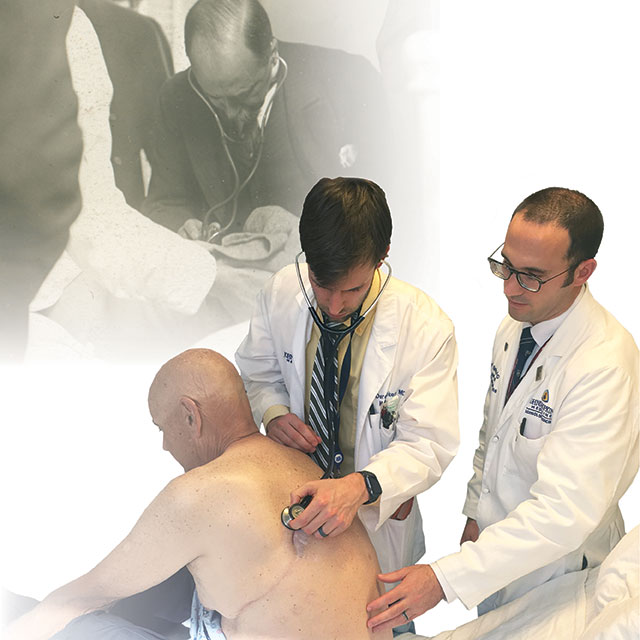From the beginning of her internal medicine residency, Eva Valilis (Longcope, 2018) expected to endure long — and sometimes intense — nights on call, caring for medically complex patients with comorbidities.
What she didn’t expect was a concerted effort by leaders to reduce trainees’ stress.
“The Osler program is rooted in tradition and hard work, yet they [its leaders] encouraged us to suggest ways to unwind,” recalls Valilis, now a Johns Hopkins oncology fellow. These included “Olympic” games, an annual tradition during which the trainees compete as firms (usually at a local park) against one another in various activities ranging from relay races to trivia. Sanjay Desai (Janeway, 2004), then the Osler Medical Residency director, was the “referee.” It was a memorable experience, says Valilis, “something we all looked forward to participating in.”
Perhaps the greatest boon to the 137 trainees’ mental health has come from the five-year Reimagining Residency grant from the American Medical Association (AMA). It’s one of eight grants from the Reimagine Residency initiative, launched in 2019. Desai and Brian Garibaldi (Longcope, 2007), associate residency program director, led the effort — in partnership with faculty from the University of Alabama at Birmingham and Stanford Medicine — to study strategies to improve resident wellness, build camaraderie, reduce burnout and strengthen clinical skills.
Then the COVID-19 pandemic upended residents’ social gatherings and limited bedside teaching. By March of 2021, as more patients with COVID-19 arrived and new protocols emerged, trainees’ stress levels intensified. So Desai and Garibaldi urged residents to consider how to tap into the AMA grant funds to boost morale.
That’s when Valilis suggested the purchase of an exercise bike. “I felt frustrated about not having time to exercise during on-call nights,” she says, a sentiment shared by other residents. When she learned that her idea would become a reality, she considered it “a first step that really showed how much resident wellness matters here.”
Valilis’ excitement went viral. She posted a photo on Twitter that a colleague took of her on the bike, along with the tweet, “Introducing the Osler resident Peloton! Winning wellness idea supported by the American Medical Association. Let the rides begin.”
The bike remains popular, Valilis notes — it is typically used before and after residents’ shifts. Natasha Chida, Osler Medical Residency director, has been buoyed by efforts like this to engage the program’s residents and address their mental health and skill building.
She says the Osler program has always focused on developing clinical excellence through bedside teaching and patient interactions. But the demands of inpatient medicine have evolved. “More time is needed in the electronic medical record, and [there are] more tasks to do that don’t involve directly speaking to patients, among other things,” Chida says.
These pressures not only impact residents’ clinical training, Chida says — they also affect wellness. “What the AMA grant has done is allow us to address this issue on multiple levels, and to enhance our existing bedside teaching efforts,” she says.
Redoubling Efforts to Hone Clinical Skills
In addition to supporting ways to improve mental health, the AMA grant provides funding to strengthen physical examination skills and patient interactions. The Assessment of Physical Exam and Communication Skills focuses on encounters with both actual and standardized patients, and enhances the bedside-based clinical education that is the foundation of the Osler residency.
Now in year three of the grant, the residency continues to strengthen the patient-doctor relationship, providing practical guidance on how to establish strong bonds during outpatient visits and televisits. “The main goal of these encounters is to ask patients the right questions,” says Garibaldi, a founder and current board member of the Society of Bedside Medicine.
“Residents need to learn about the patient’s job security, who they live with, financial and family issues, and their ability to access healthy foods,” he says. “It’s not just about focusing on medical conditions. They need to really get to know their patients” by listening well, explaining concerns and finding out if medications are working.
“Ultimately,” Garibaldi says, “we hope these conversations will translate into better outcomes for patients.”
Drawing from Data and Practice to Empower Trainees
Incrementally, Garibaldi and other Osler Medical Residency leaders have been measuring residents’ well-being, as well as their interactions with patients, through monthly surveys about stress, burnout and fulfillment. These large-scale data will be combined with other data on resident experiences, well-being and standardized assessments of outpatient clinical skills, says Garibaldi.
Heather Sateia, the Osler Medical Residency’s associate program director for well-Being and evaluation, says that during the pandemic, she’s been impressed by efforts to forge strong bonds with patients — in person or via telemedicine. “It’s been a really rewarding experience watching a faculty member explain how to build communication skills, create a more robust and intentional connection with patients and decrease burnout,” she says.
Regarding inpatient care, Sateia says, “We send out monthly surveys about stress, burnout and fulfillment. Some residents volunteer to wear infrared tracking badges, so that we can understand workflow in the hospital.” Mentors can also examine in the electronic health record how residents spend time “to better understand points of stress,” adds Garibaldi.
Fostering Optimism and Engagement
Ultimately, says Sateia, these practices will have enduring impact. Program leaders will continue to identify and inform the design of the “optimal learning environment” for residents — “one that is evidence-based to reduce burnout and improve clinical skills effectively,” she explains. It’s “an approach that can be replicated nationally.” she says.
“We needed to get back to the roots of medicine,” Garibaldi says. “And, we believe that residents who spend more time at the bedside are more likely to feel satisfaction, engage more with patients and have decreased levels of burnout.”
Valilis can attest to the success of this approach. “At times, people can feel overwhelmed,” she says. “The program is very flexible and links people to help. My wellness was never better than it was during residency — even working 70 to 80 hours per week, I didn’t have that balance in college, nor in med school. I’m really grateful.”


